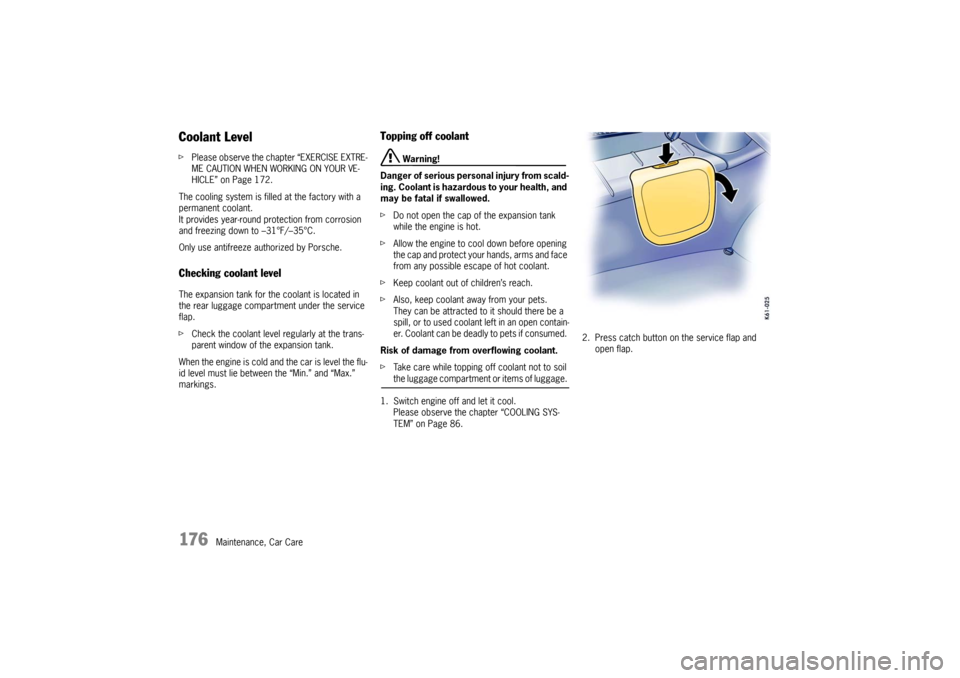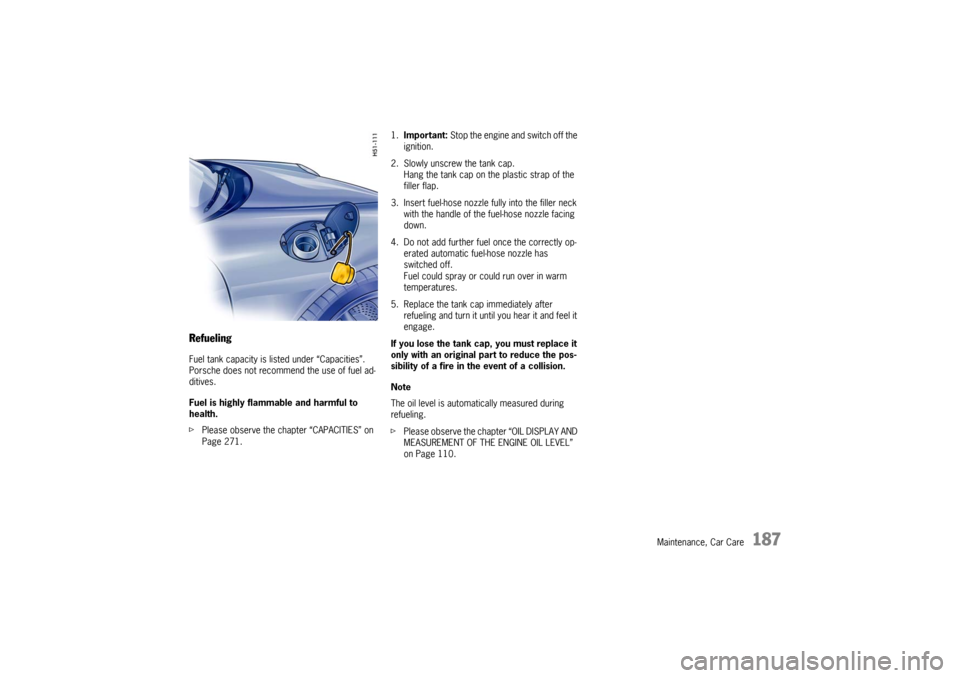engine oil PORSCHE CAYMAN 2006 1.G User Guide
[x] Cancel search | Manufacturer: PORSCHE, Model Year: 2006, Model line: CAYMAN, Model: PORSCHE CAYMAN 2006 1.GPages: 280, PDF Size: 4.89 MB
Page 118 of 280

118
Controls, Instruments
Airbag system fault Airbag is faulty.
Have the fault remedied at an authorized
Porsche dealer.
Check passenger’s seat setting Weight sensing is impaired on the passenger's
seat (Advanced Airbag).
When the backrest is in contact with the engine
compartment wall, the backrest can warp.
Correct the seating position, set the backrest
upright, do not support weight on the armrests,
or lift on the handles.
Failure spoiler control Driving stability is impaired.
Adjust your driving style. Reduce speed.
Have the fault remedied at an authorized
Porsche dealer.
Display of
selector lever posi-
tion flashesSelector lever is not engaged Tiptronic S:
Selector lever can be between two positions.
Engage the selector lever correctly.
Move selector lever to P Tiptronic S:
Move selector lever to position P before with-
drawing key from ignition lock.
Apply brake Tiptronic S:
Apply the brake when starting.
Depress clutch pedal Manual transmission:
Depress clutch pedal when starting.
Move selector lever
to position P or NTiptronic S:
The vehicle can be started only in the selector
lever position P or N.
Display of
selector lever posi-
tion flashesTiptronic emergency run Have the fault remedied at an authorized
Porsche dealer.
Instrument
panelOn-board
computerText display on on-board
computerMeaning/measure
Page 151 of 280

Controls, Instruments
151
Rear Luggage CompartmentService flapfPress catch button on the service flap and
open flap.
A - Topping up engine oil.
B - Checking coolant level or topping up.
Luggage net, tie-down rings
Warning!
Danger of injury during braking, rapid direc-
tion changes or in an accident.
fDo not carry items of luggage or objects in the
passenger compartment unsecured.
Secure load against sliding.
fDo not transport heavy objects under the lug-gage net. fHang the luggage net on the 4 tie-down rings
around the engine cover or in the rear luggage
compartment.
Page 171 of 280

Maintenance, Car Care
171 Maintenance, Car Care
Exercise Extreme Caution when Working on your
Vehicle ..................................................... 172
Wiper Blades ............................................ 173
Coolant Level ............................................ 176
Engine Oil ................................................. 178
Engine Oil Level ........................................ 178
Engine Oil Recommendation ....................... 180
Brake Fluid Level ....................................... 182
Fuel Economy ........................................... 184
Operating Your Porsche in other Countries .. 185
Fuel .......................................................... 186
Fuel Recommendations .............................. 188
Portable Fuel Containers ............................ 189
Emission Control System ........................... 190
How Emission Control Works ...................... 191
Fuel Evaporation Control ............................ 191
Washer Fluid ............................................. 192
Power Steering ......................................... 193
Air Filter ................................................... 194
Combination filter ...................................... 194
Automatic Transmission Fluid ..................... 194
Manual Transmission Oil ............................. 194
Car Care Instructions ................................. 195
Page 172 of 280

172
Maintenance, Car Care
Exercise Extreme Caution when
Working on your Vehicle
Danger!
Ignoring the following instructions may
cause serious personal injury or death.
fThe engine compartment of any motor vehicle
is a potentially hazardous area. If you are not
fully familiar with proper repair procedures, do
not attempt the adjustments described on the
following pages.
This caution applies to the entire vehicle.
fO n l y w o r k o n y o u r v e h i c l e o u t d o o r s o r i n a w e l l
ventilated area.
fEnsure that there are no open flames in the
area of your vehicle at any time when fuel
fumes might be present. Be especially cau-
tious of such devices such as hot water heat-
ers which ignite a flame intermittently.
fBefore working on any part in the engine com-
partment, turn the engine off and let it cool
down sufficiently. Hot engine compartment
components can burn skin on contact.
fBe alert and cautious around engine at all
times while the engine is running.
If work has to be performed with the engine
running, always set the parking brake, and
make sure the shift lever is in neutral or the se-
lector lever is in position P or N. fIn particular, be very careful to ensure that
items of clothing (ties, shirt, sleeves etc.), jew-
elry, long hair, hand or fingers cannot get
caught in the engine-compartment blower, fan,
belts or other moving parts.
The radiator and radiator fans are in the front
of the car.
The fans can start or continue running as a
function of temperature, even with the engine
switched off.
Carry out work in these areas only with the en-
gine off and exercise extreme caution.
fYour Porsche is equipped with an electronic ig-
nition system. When the ignition is on, high volt-
age is present in all wires connected with the
ignition system; therefore, exercise extreme
caution when working on any part of the engine
while the ignition is on or the engine is running.
fAlways place the vehicle on stable supports if
work has to be carried out under the vehicle.
Jacks are not suitable for this kind of work.
fWhen working under the car without safety
stands but with the wheels on the ground,
make sure the car is on level ground, the
wheels are blocked, and that the engine can-
not be started.
Remove the ignition key. fDo not smoke or allow an open flame around
the battery or fuel.
Keep a fire extinguisher close at hand.
fIncomplete or improper servicing may cause
problems in the operation of the car. If in doubt
about any servicing, have it done by your au-
thorized Porsche dealer.
Improper maintenance during the warranty pe-
riod may affect your Porsche warranty cover-
age.
fSupplies of fluids, e.g. engine oil, brake fluid or
coolant, are hazardous to your health.
Keep these fluids out of children’s reach and
dispose of them in accordance with the appro-
priate regulations.
fSome countries require additional tools and
special spare parts to be carried in your vehi-
cle.
Please make enquiries before driving abroad.
Power measurements Power measurements on dynamometers are not
approved by Porsche. Working in the engine compartmentHave the necessary work in the engine compart-
ment done by a qualified specialist workshop.
We recommend that you use your authorized
Porsche dealer for carrying out this work.
Page 176 of 280

176
Maintenance, Car Care
Coolant Level fPlease observe the chapter “EXERCISE EXTRE-
ME CAUTION WHEN WORKING ON YOUR VE-
HICLE” on Page 172.
The cooling system is filled at the factory with a
permanent coolant.
It provides year-round protection from corrosion
and freezing down to –31°F/–35°C.
Only use antifreeze authorized by Porsche. Checking coolant level The expansion tank for the coolant is located in
the rear luggage compartment under the service
flap.
fCheck the coolant level regularly at the trans-
parent window of the expansion tank.
When the engine is cold and the car is level the flu-
id level must lie between the “Min.” and “Max.”
markings.
Topping off coolant
Warning!
Danger of serious personal injury from scald-
ing. Coolant is hazardous to your health, and
may be fatal if swallowed.
fDo not open the cap of the expansion tank
while the engine is hot.
fAllow the engine to cool down before opening
the cap and protect your hands, arms and face
from any possible escape of hot coolant.
fKeep coolant out of children’s reach.
fAlso, keep coolant away from your pets.
They can be attracted to it should there be a
spill, or to used coolant left in an open contain-
er. Coolant can be deadly to pets if consumed.
Risk of damage from overflowing coolant.
fTake care while topping off coolant not to soil the luggage compartment or items of luggage.
1. Switch engine off and let it cool.
Please observe the chapter “COOLING SYS-
TEM” on Page 86.2. Press catch button on the service flap and
open flap.
Page 178 of 280

178
Maintenance, Car Care
Engine Oil Engine oil consumption
It is normal for your engine to consume oil.
The rate of oil consumption depends on the quality
and viscosity of oil, the speed at which the engine
is operated, the climate, road conditions as well
as the amount of dilution and oxidation of the lubri-
cant.
If the vehicle is used for repeated short trips, and
consumes a normal amount of oil, the engine oil
measurement may not show any drop in the oil lev-
el at all, even after 600 miles (1000 km) or more.
This is because the oil is gradually becoming dilut-
ed with fuel or moisture, making it appear that the
oil level has not changed.
The diluting ingredients evaporate out when the
vehicle is driven at high speeds, as on an express-
way, making it then appear that oil is excessively
consumed after driving at high speeds.
If the conditions you drive your vehicle in are
dusty, humid, or hot, the frequency of the oil
change intervals should be greater. If the vehicle is driven at a high rate of speed, cli-
matic conditions are warm, and the load is high,
the oil should be checked more frequently, as driv-
ing conditions will determine the rate of oil con-
sumption.
– The engine in your vehicle depends on oil to lu-
bricate and cool all of its moving parts.
Therefore, the engine oil should be checked
regularly and kept at the required level.
– Make it a habit to have the engine oil level
checked with every fuel filling.
– The oil pressure warning light is not an oil level
indicator.
The oil pressure warning light indicates serious
engine damage may be occurring when lit, if
engine rpm is above idle speed.
Engine Oil Level fPlease observe the chapter “EXERCISE EXTRE-
ME CAUTION WHEN WORKING ON YOUR VE-
HICLE” on Page 172.
fRegularly check the oil level using the on-board
computer after the vehicle is refuelled.
Please observe the chapter “OIL DISPLAY AND
MEASUREMENT OF THE ENGINE OIL LEVEL”
on Page 110.
The difference between the minimum and maxi-
mum marks on the segment display is approx.
1.2 liters.
Each segment of the display corresponds to
approx. 0.4 liter.
Page 179 of 280

Maintenance, Car Care
179
Topping off engine oil
Warning!
Engine oil is hazardous to your health and
may be fatal if swallowed.
fKeep engine oil out of children’s reach.
Used engine oil contains chemicals that have
caused cancer in laboratory animals.
fAlways protect your skin by washing thorough-ly with soap and water. Caution!
Risk of damage from overflowing engine oil.
fTake care while checking and topping up en-
gine oil not to soil the luggage compartment or items of luggage.
The oil inlet opening is in the rear luggage com-
partment under the service flap. 1. The on-board computer indicates how much oil
must be added.
2. Press catch button on the service flap and
open flap.3. Unscrew cap of the oil filler opening.
4. Add at most half a liter of engine oil at a time.
5. Measure oil level again with the on-board
computer.
6. Add more engine oil if necessary.
Never add more engine oil than required
to reach the max. mark.
7. Close cap carefully.
8. Close service flap.
Page 180 of 280

180
Maintenance, Car Care
Engine Oil RecommendationRecommended oil viscosity ranges dependent on ambient temperaturesSuitable oils are:fUse only engine oils tested and approved by Porsche (Porsche approval list).
Your authorized Porsche dealer will be pleased to advise you.
fYou will find a sticker in the service flap which provides information (manufacturer) about the initial factory filling of your engine.
fGenerally you can find the manufacturer suggestions on the oil containers or as a bulletin on the market. Ambient temperature
seasonalSAE Viscosity Range
engine oils
generally above –13°F/–25 °CSAE 0W-40, 5W-40, 5W-50
approved by Porsche
generally below –13°F/–25 °C SAE 0W-40 approved by Porsche
Page 181 of 280

Maintenance, Car Care
181
Oil changeThe engine oil has to be changed at the intervals
listed in your Maintenance Schedule.
fPlease observe the chapter “CAPACITIES” on
Page 271.
We recommend that you have the engine oil
changed at your Porsche dealer, who has the re-
quired oils and the necessary filling equipment.
If you suspect an oil leak in the engine have your
dealer check it out immediately.
All current engine oils are compatible with each
other, i. e. when making an oil change it is not nec-
essary to flush the engine if you wish to use a dif-
ferent brand or grade of oil.
Since, however, each brand of oil has a special
composition, you should, if possible, use the
same oil brand if it becomes necessary to top up
between oil changes.
Porsche engines have long intervals between oil
changes. You can make best use of these long oil
change intervals by using multigrade oils since
these are largely independent of seasonal fluctua-
tions in temperature.If your vehicle is used frequently in stop-and-go
traffic in cold weather, the engine will not always
be completely warmed up.
Condensation from products of combustion may
accumulate in the oil. In this case, it is advisable
to change the oil more frequently so that your en-
gine once again has 100% efficient oil.
Engine oil performance classEngine oil is not only a lubricant, but also serves
to keep the engine clean, to neutralize the dirt
which penetrates into the engine through combus-
tion and to protect the engine against corrosion.
To perform these functions, the oil is provided with
additives which have been specially developed for
these functions.
The efficiency of an oil is expressed, for example,
by the API, ILSAC or ACEA classifications.
ViscosityLike all liquids, engine oil is viscous when cold,
and thin-bodied when warm. The viscosity of an oil
is expressed by its SAE class. For cold viscosity
(measured at temperatures below 32°F/0°C) the
SAE class is given as a number and the letter ”W“
(as in winter), for hot viscosity (measured at
212°F/100°C) the SAE class is given only as a
number.
The viscosity of an oil is, therefore, always the
same if it has the same number of an SAE class.
Oils with two viscosities are called multigrade oils;
oils with only one viscosity are termed single-
grade oils.
Single-grade oils can not be used in your engine.
The viscosity of the engine oil for your Porsche
has to be selected according to the ambient tem-
perature given in the engine oil recommendation
table.
Page 187 of 280

Maintenance, Car Care
187
Refueling Fuel tank capacity is listed under “Capacities”.
Porsche does not recommend the use of fuel ad-
ditives.
Fuel is highly flammable and harmful to
health.
fPlease observe the chapter “CAPACITIES” on
Page 271.1.Important: Stop the engine and switch off the
ignition.
2. Slowly unscrew the tank cap.
Hang the tank cap on the plastic strap of the
filler flap.
3. Insert fuel-hose nozzle fully into the filler neck
with the handle of the fuel-hose nozzle facing
down.
4. Do not add further fuel once the correctly op-
erated automatic fuel-hose nozzle has
switched off.
Fuel could spray or could run over in warm
temperatures.
5. Replace the tank cap immediately after
refueling and turn it until you hear it and feel it
engage.
If you lose the tank cap, you must replace it
only with an original part to reduce the pos-
sibility of a fire in the event of a collision.
Note
The oil level is automatically measured during
refueling.
fPlease observe the chapter “OIL DISPLAY AND
MEASUREMENT OF THE ENGINE OIL LEVEL”
on Page 110.